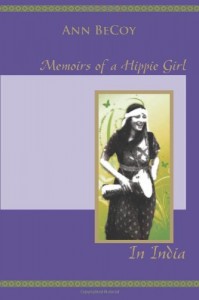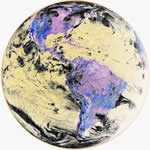Flowers and Seeds:
Memoirs of a Hippie Girl In India by Ann BeCoy
By Chinmaya Dunster
 By Nomad Tales from Australia (Hippies at the Ghat Uploaded by Ekabhishek) [CC-BY-SA-2.0],
By Nomad Tales from Australia (Hippies at the Ghat Uploaded by Ekabhishek) [CC-BY-SA-2.0], via Wikimedia Commons

It is a rare person who can review their life without resorting to spin; after all, who among us truly wants to portray ourselves publicly, warts and all? Ann BeCoy, in writing about her year in India in 1972, has achieved this feat and taken the reader inside the mind of a naïve 19-year old from Toronto who accidentally finds herself on a continent about which she knows absolutely nothing.
BeCoy originally wrote in 1984, just twelve years after the experiences she describes, using the third person. This re-write, which was published in September 2013, in the first person, resists all temptations to comment from a mature perspective and allows us to participate in her journey as if we travelled with her. What a journey it was!
And what an era it was. The hippy phenomenon had flowered and gone to seed in the West, but it lived on in the mass migration to the mystic East that took place on the road to Kathmandu in the 1970’s. Suddenly, the answers to questions about peace and love, free sex and drug use seemed to have answers in an ancient culture that had pondered such matters for millennia. There were sadhus-- spiritual mystics-- who used pot; gurus advocating free sex based on Tantric scriptures; and religions like Jainism that were based on non-violence to all living creatures.
BeCoy knew none of this when she followed a boyfriend on a whim and landed in Bombay. She knew that drugs were involved and shady deals, men older than she was who found her attractive. She was totally unprepared for an India that in return knew nothing of hippies except their reputation for nudity and being free and easy in matters sexual. The clothes she brought with her–- miniskirts!-– lead her into a near-riot in the bazaar, and the sexually frustrated son of a middle-class Indian family who invites her to stay with them invades her bed one night.
I found BeCoy’s description of her months in Bombay’s Arthur Road jail simply riveting. Her writing gets repetitive here, but this technical flaw actually heightened the reading experience for me, because her lonely days were repetitive in the extreme. Isolated from the two men busted with her, and the sole Westerner in a group of Hindi-speaking women inmates, she alternates between despair at the labyrinthine legal processes, guilt at deceiving her parents (she sends them postcards describing fictional days exploring India), and disillusionment with the god of her Christian upbringing who refuses any response to her desperate prayers for release.
Even in this spiritual crisis, however, she proves to be way out of her depth. The hippies she spends time with in Goa, Delhi and Rishikesh are busy doing the rounds of the spiritual supermarket, and BeCoy gets to tag along to meetings with Osho (Bhagwan Rajneesh), Krishnamurti, Neem Karoli Baba et al., but BeCoy is far too immature to get much from any of them. There is a rare description of a personal encounter with Osho in which he experiments with energy work on her, but her 19-year old sexual hang-ups leave her seeing it all in terms of lust and leaving in disgust (just how confused it leaves her shows when she keeps the sanyas name, Diksha, that he gives her). Similarly, she admits that Krishnamurti’s talk is way over her head.
Poor BeCoy finds herself always an outsider, trying to adapt to two cultures (traditional India and hippy) that are both alien to her. She makes an effort, switching her mini-skirt for a sari, and going along to opium dens with the boys, and there are transitory moments of happiness, like a friendship in jail with a prostitute who teaches her chapati-making and Hindi songs and dances, and when two Osho sanyasins, Tony and Rene, bring her books and fruit in jail and befriend her upon her release. But young BeCoy seems to have a knack for picking losers, and her crisis comes to a head when her lover abandons her in an isolated cabin in the Himalayas. Soon, she is left with just two down-and-out drug runners to choose between as company. Inevitably her choice leads to a run, and the remainder of the book deals with the consequences as she lands back in Canada.
In resisting the temptation to comment as an author, BeCoy leaves the reader with many questions around what influence her six months in India has had on her life since (I look forward to the publication of Part 2, in which she promises to address this) and also pondering the general significance of the 60’s. Today’s interest in vegetarianism, Eastern spirituality, and non-violent resistance all have roots in the collision between the 60’s counter culture and India. Tibetan temples sprout in California, the Dalai Lama can command devoted crowds that everyday politicians must envy, Osho’s language has influenced nearly every spiritual teacher on the planet, and marijuana use is currently being legalized around the globe. Even if they are not fully aware of it, BeCoy’s heirs, the backpackers who today throng Goa’s beaches and Dharamsala’s hills, still imbibe a heady fusion of India’s vibe together with their cappuccinos and bongs. What they bring back with them and what they do with what they bring is an ongoing question for the world, as it must be for Ann BeCoy.
About the author

Chinmaya Dunster is a world-renowned musician, writer, artist and filmmaker. He traveled the Hippy Trail from England to India in 1974, where he fell in love with Osho, the sarod and Indian classical music. in the following decades, he explored the crossroads between Indian classical and various Wetern musical traditions, released more than a dozen CDs, and created films dedicated to spreading a message of conservation in India. He now lives with his family in New Zealand.
For links to Chinmaya's music, films and current projects: www.chinmaya-dunster.com
Please subscribe to our new article alert and/or RSS feeds.
Did you like the review? Have you read this book? What do you think?
Please leave your comments below:
Advertisement
